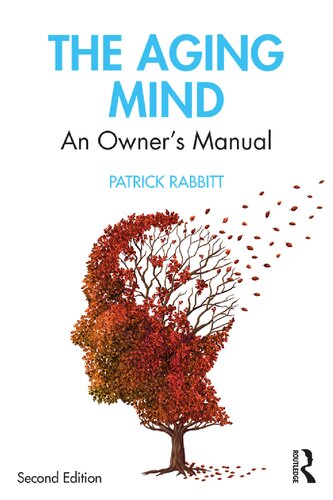(EBOOK PDF)The Aging Mind An Owner’s Manual 2nd Edition by Patrick Rabbitt 9781351035200 1351035207 full chapters
$50.00 Original price was: $50.00.$35.00Current price is: $35.00.
The Aging Mind An Owner’s Manual 2nd Edition by Patrick Rabbitt- Ebook PDF Instant Download/Delivery: 9781351035200, 1351035207
Full download The Aging Mind An Owner’s Manual 2nd Edition after payment

Product details:
• ISBN 10:1351035207
• ISBN 13:9781351035200
• Author:Patrick Rabbitt
The Aging Mind
An Owner’s Manual
The Aging Mind offers an accessible introduction to what research has revealed about how our bodies and brains age, and how these changes affect our everyday experiences and lives. This second edition is fully updated with contemporary studies and neuroscientific findings, to offer an engaging exploration of 25 facets of the physical and mental aging processes. Written by eminent gerontologist Patrick Rabbitt, who interprets research through his own personal daily experiences, it explores what aging really is and how to accept and manage it. It explores why our sensory and cognitive experiences change as we get older, and what these developments mean for our overall physical and emotional well-being. Key topics explored include memory, intelligence, attention, sleep, vision and hearing, taste and smell, touch and balance, anxiety, depression and perception of the passage of time. It also discusses how far we can keep and develop the skills we have mastered over our lifetimes. The Aging Mind debunks unhelpful myths about the aging process and offers guidance on how we can age better, allowing us to continue to manage and enjoy our lives. This second edition is invaluable for students and researchers of cognitive gerontology, for professionals working with clients experiencing issues around aging, and for all those interested in understanding their own, or their relatives’ aging.
The Aging Mind An Owner’s Manual 2nd Table of contents:
1 Talking about old age
PART I What is aging?
2 Why and how do we age?
Why we could not live for ever
Not all for each but each for all
High costs of sex
Some advantages of reproducing later in life
Advantages of married life
Why women live longer
Notes
3 How fast do we change?
Collecting evidence
The past is another country where things were very different
Geographical differences
Tracking individual lives
Time from our beginning and from our end
Clever genes and long-life genes
Does it all go together when it goes?
Notes
4 How well do we understand what is happening to us?
Asking people about their everyday competence
Feeling low and scoring low
Judging how well we are and how long we will survive
What do we compare our health against?
How can we assess ourselves more accurately?
Notes
5 Biological signs of brain aging
The falling years
Seeing and hearing our futures
Working out the exact amounts by which age affects intelligence, vision and balance
Measuring and using gross changes in the brain
Notes
PART II Memory
6 What is memory for?
How working memory works
Notes
7 Remembering and planning to do things
Looking for things
Unconscious awareness of plans
8 Who said that?
Linking sources to content
Forgetting to whom you told your story
9 Losing and finding words and names
The natural history of TOTs
I’ll never forget what’s-his-name
Naming faces
Words in the brain
Note
10 Remembering the beginnings of our lives
Blight out of mind?
Language and early memories
Do our earliest memories alter as we age?
How our early memories construct our life stories
11 Remembering the rest of our lives
Which parts of our lives do we remember best?
Flashbulb memories
Remembering what we have learned
PART III Senses
12 Seeing
Our best guesses about reality
A look at the eye
Notes
13 Hearing
The ear
Hearing where things are
Particular hearing losses
Obvious and less obvious problems of being deaf
Note
14 Taste and smell
Note
15 Fumbling and stumbling
Notes
PART IV Intelligence, skills and wisdom
16 General smarts
What do intelligence tests measure?
Testing times
17 Keeping the skills we have learned
But what about “the wisdom of old age”?
What is wisdom?
Notes
18 Reading others’ minds
Dialects of the face
Recognising faces and expressions as we grow old
When faces, voices and bodies give different messages
What goes on in the brain when we recognise non-verbal cues?
Accentuating the positive
Back to the brain again
Our inner others: modelling minds
PART V Living with aging
19 Those old blues: depression and anxiety
Various shades of blues
The final stress
20 The speed of thought
Note
21 Paying attention
Preparing
Staying prepared
Staying prepared
Notes
22 Good times and bad times
Variability from moment to moment
Variability from day to day
Regular changes during each day
Notes
23 Sleep
Daily rhythms
Larks and owls
Is poor sleep a warning signal?
In our sleep what dreams may come?
Note
24 Time passing
Judging very short periods of time
Hour glasses of our lives
Memories of past times
Time at the magic mountain
How long ago was that?
Mind maps of space and time
Notes
PART VI Aging well
25 What can we do about all this?
Things that help to keep our wits
Training can change the brain
Brain-training programmes
Some disagreements between results
Memory improvement systems
Why we can, and should, literally, take heart
Index
People also search for The Aging Mind An Owner’s Manual 2nd:
the aging mind an owner
the aging mind
the aging mind foundation
the aging mind opportunities in cognitive research
the aging mind potential and limits
Tags:
The Aging,Manual 2nd Edition,Patrick Rabbitt



